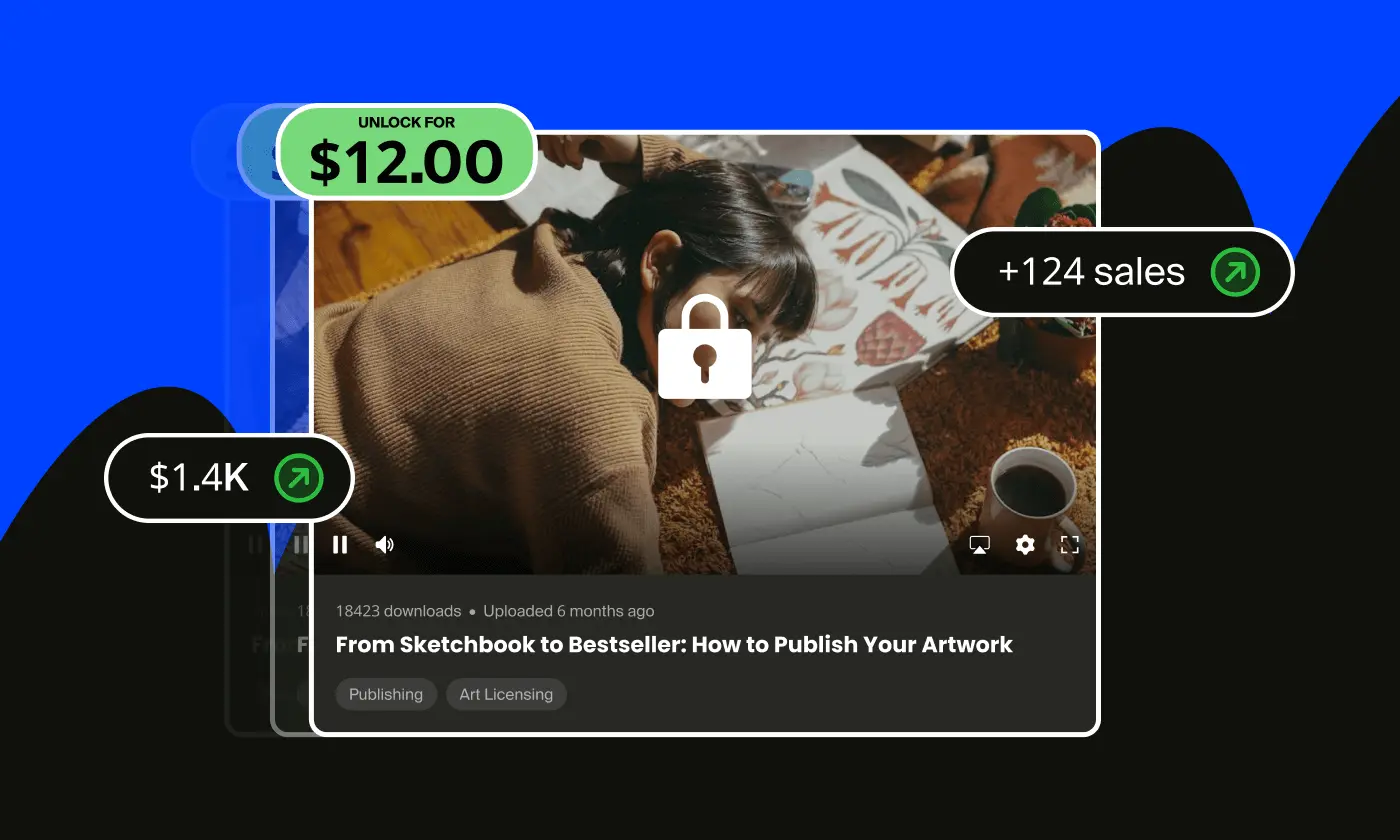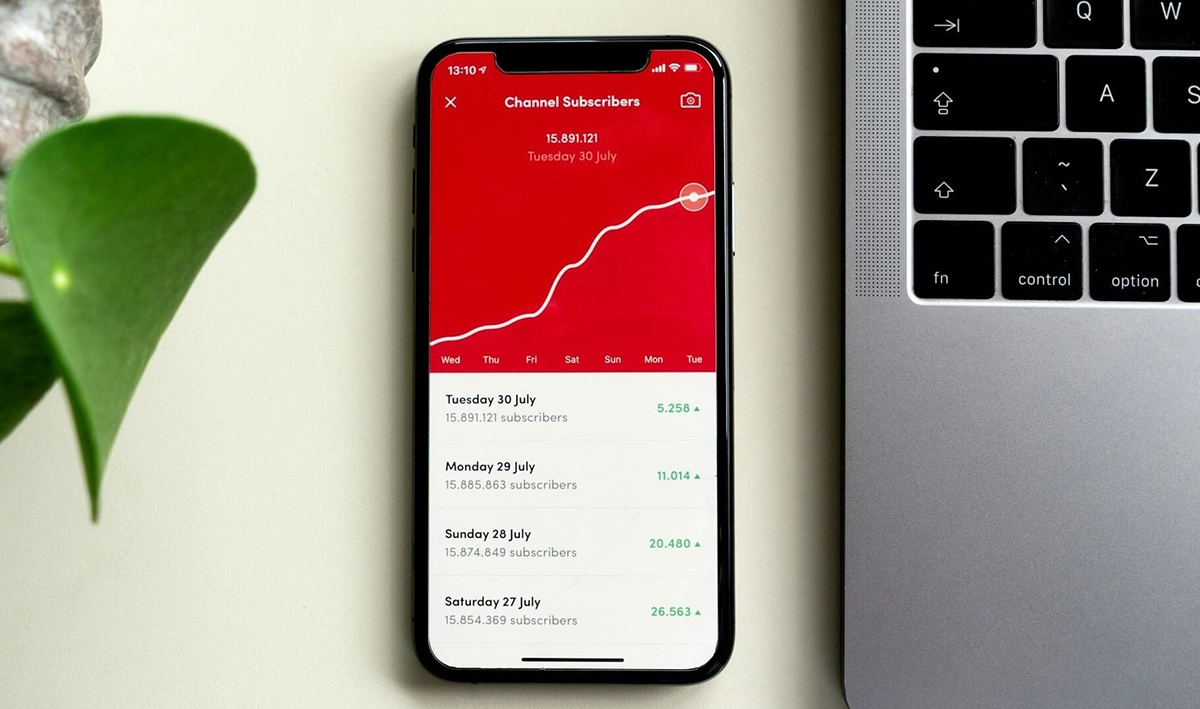How to Sell Video Content: A Guide for Creators

Media consumption has experienced a dramatic shift in recent years, with online video content becoming the dominant force in entertainment.
Traditional mediums like cable and satellite television are gradually dwindling while digital platforms continue to thrive, offering vast opportunities for studios, businesses, and creators alike.
This transformation has opened up new avenues for monetizing video content, allowing creators and brands to reach a global audience and generate significant revenue.
However, navigating the complexities of online video monetization can be challenging. In this article, we will guide you through the strategies and tools needed to successfully monetize your video content and capitalize on this growing market.
Why Sell Videos Online?

With the growing demand for video content across platforms like Vimeo, YouTube, TikTok, and Twitch, the opportunity for content creators to sell their videos directly to their audience has never been more promising.
Selling videos online allows creators to bypass traditional advertising models by eliminating the reliance on third-party platforms and advertisers to generate revenue.
For instance, in traditional models, creators often depend on ad placements, sponsorships, or platform algorithms to earn income, which can be unpredictable and subject to change. These platforms typically take a significant revenue cut, leaving creators with only a portion of their earnings.
By selling videos directly to their audience, creators can set their own prices and choose how and where their content is distributed, ensuring they receive the full value of their work. This direct-to-consumer approach allows for greater transparency, as creators can see exactly how much they’re earning without worrying about changes in ad revenue or algorithm shifts.
In addition, this approach empowers creators to build a more loyal and engaged audience, as viewers who purchase content are more likely to be invested in the creator’s work. This model offers creators more financial independence, stability, and the ability to grow their brand on their own terms.
Benefits of Selling Videos Online
Ownership and Control
One of the most significant benefits of selling videos online is the complete ownership and control you maintain over your content. Unlike platforms that dictate how and when your content can be used, selling directly allows you to:
- Set Your Prices: Determine the value of your work and charge accordingly. Whether you choose to price your videos as premium content or offer them at an accessible rate, the decision is entirely yours.
- Choose Distribution Channels: Decide where and how your content is distributed. Whether you want to offer your videos exclusively on your own website, through a third-party platform, or across multiple outlets, you have the freedom to choose the best strategy for your brand.
- Determine Monetization Strategies: Tailor your monetization methods to align with your business goals. Whether you prefer subscription-based models, pay-per-view, or selling digital downloads, you have the flexibility to design a monetization strategy that works for you.
This level of control not only allows you to maximize your earnings but also ensures that your content is represented and distributed in a way that aligns with your vision and goals.
Increased Revenue Streams
When you sell directly to your audience, you’re not limited to traditional advertising revenue. Instead, you unlock a variety of monetization options that can significantly boost your income. Luckily, Fourthwall provides video creators with a few options to help monetize their content online:
- Subscriptions: Set up subscription-based memberships on platforms like Fourthwall. With Fourthwall's flexible membership system, you can create different tiers that provide varying levels of access, such as early access to videos, behind-the-scenes content, personalized shoutouts, and more. This allows you to tailor your offerings to suit different segments of your audience. You can also create membership posts that anyone can see but only members can interact with, turning your fanbase into a thriving community.
- Digital Downloads: Sell video files for download and allow your audience to own their favorite content permanently and watch it offline. Whether it's an online course, video podcast, or exclusive content, digital downloads allow you to share your expertise and creative work in multiple formats, giving your audience the opportunity to learn, engage, or enjoy your content on their terms. With intuitive uploading, easy categorization, and instant delivery, Fourthwall makes downloading digital content hassle-free for all creators.
- Merchandise: Selling merchandise through Fourthwall is an effective way to monetize your video content and strengthen your brand. By offering branded products such as t-shirts, hats, posters, or other items that resonate with your audience, you not only create additional revenue streams but also deepen the connection with your fans. Merchandise allows your audience to showcase their support for your content in a tangible way, turning them into brand ambassadors who spread the word about your work.
- Personalized Video Messages: Offering customized thank-you video messages or shoutouts tailored to individual fans can significantly enhance audience engagement. With Fourthwall, you can easily create and send personalized videos to supporters who contribute during checkout, adding a unique and memorable touch to their experience.
This diversified approach to monetization ensures that you're not overly reliant on any single revenue source, providing greater financial stability and the potential for substantial earnings.
Deeper Fan Engagement
Selling videos directly to your audience allows for more meaningful interactions that can foster a deeper sense of community and loyalty. By offering exclusive content and perks such as behind-the-scenes footage, early access to new videos, or live Q&A sessions, you can make your fans feel like they’re part of something special.
Engaging directly with your audience—through comments, social media, or private messages—further strengthens this connection. A loyal and dedicated fanbase is crucial for long-term success, as these fans are more likely to support your work, recommend it to others, and remain engaged over time.
Minimum Costs
One of the most significant advantages of selling videos online is the minimal overhead involved. Unlike traditional distribution methods, which may require expensive physical media production, shipping, and storage, digital distribution significantly reduces these costs.
You don't need to worry about printing DVDs, managing inventory, or dealing with shipping logistics. Instead, your primary expenses might include hosting fees, payment processing charges, and possibly marketing efforts. This leaner cost structure allows you to retain a higher percentage of your earnings, making your venture more profitable from the outset.
Additionally, the scalability of online sales means you can start small and grow without significant upfront investment, allowing you to focus your resources on content creation and audience engagement.
Data and Insights
When you sell your videos directly, you gain access to valuable data and insights about your audience. This information can include:
- Purchase Behavior: Understand what types of content your audience is most willing to pay for, helping you tailor future offerings to meet their preferences.
- Viewer Demographics: Gain insights into who is watching your videos—such as their age, gender, location, and interests—which can inform your marketing strategies and content creation.
- Content Performance: Track which videos are performing best in terms of views, engagement, and sales. This will allow you to focus on creating more content that resonates with your audience.
These insights are crucial for making informed decisions about your content strategy, pricing, and overall business direction. By understanding your audience better, you can continuously refine your approach to meet their needs and maximize your success.
5 Easy Steps to Monetize Your Videos
Monetizing your video content is a strategic process that involves several factors. By following the steps below, you can transform your passion for video creation into a profitable venture.
1. Identify Your Target Audience

Understanding your target audience is the cornerstone of successful video monetization, as it allows you to create content that truly resonates with those most likely to engage with it.
Start by conducting in-depth audience research, gathering data on demographics, interests, preferences, and behaviors using tools like Google Analytics, social media insights, and surveys. This data is invaluable in helping you create detailed audience personas—fictional representations of your ideal viewers that guide your content creation and marketing strategies.
For example, if you’re a fitness creator, you might develop personas for a 30-something professional interested in quick, high-intensity workouts and a 50-something individual focused on low-impact exercises. Analyzing your existing audience is equally important; by studying your current subscribers or followers, you can further identify patterns and preferences that refine your target audience definition.
2. Create High-Quality Content

Investing in quality equipment, such as good lighting, audio, and video capture tools, can dramatically elevate your production values, making your videos more visually appealing and easier to watch.
Equally important is mastering video editing techniques; polished, professional-looking content is more likely to be shared and appreciated. Developing a consistent content style that aligns with your brand and resonates with your audience helps build recognition and trust.
A content calendar is also crucial—planning your videos in advance ensures consistency and helps you avoid creative blocks. Additionally, optimizing video length based on your audience's preferences can significantly improve viewer retention.
For example, while some educational channels thrive with in-depth 20-30 minute videos, others succeed with short, snappy 5-minute segments. By focusing on these elements, you can create content that not only attracts viewers but also converts them into loyal fans.
3. Choose Your Distribution Model

When selling your videos online, you have many distribution models to choose from, each offering unique advantages tailored to different types of content and audience engagement.
SVOD (Subscription Video on Demand)
Subscription Video on Demand is a widely popular monetization model utilized by OTT (Over-the-Top) video platforms, where users pay a recurring subscription fee—often monthly or annually—in return for unlimited, ad-free access to an extensive library of video content.
This model is highly appealing to consumers, as it allows them to binge-watch shows, discover new series, and explore a variety of genres on their own schedule, all for a flat fee. For creators, SVOD offers a steady and predictable revenue stream, enabling them to invest in high-quality content and continuously expand their offerings.
Creators can leverage SVOD not only on traditional streaming platforms like Netflix, Hulu, Disney+, and Amazon Prime Video but also through certain social media platforms. For example, platforms like YouTube, Twitch, and Vimeo allow creators to sell subscription-based access to exclusive video content, allowing them to build a loyal following while generating consistent income.
When it comes to distribution models, SVOD is typically the go-to for most creators as it gives them more control over their distribution and monetization capabilities.
TVOD (Transactional Video on Demand)
Transactional Video on Demand is a monetization model where viewers pay a one-time fee to access a specific video or piece of content. Unlike subscription-based models, where users pay a recurring fee for access to a broad library of content, TVOD allows consumers to purchase or rent individual titles without any ongoing commitment.
This model is particularly popular for premium content such as newly released movies, exclusive events, or niche films that may not be widely available on streaming platforms. Content creators and distributors benefit from TVOD by earning revenue directly from each purchase or rental, making it a lucrative option for high-demand or specialized content.
TVOD is often divided into two subcategories: Electronic Sell-Through (EST), where consumers purchase and own digital copies of the content, and Download-to-Rent (DTR), where access is granted for a limited time. This model is commonly used by platforms like iTunes, Google Play, and Amazon Prime Video, allowing creators to capitalize on the immediate value of their content.
AVOD (Advertising Video on Demand)
Advertising Video on Demand is a model where content is free to watch, and revenue is generated through advertisements. AVOD is an attractive alternative to subscription-based services, as it allows users to enjoy content without any direct financial cost, making it accessible to a broader audience. In this model, advertisers pay the content platform to display their ads to viewers, and revenue is typically shared between the platform and the content creators.
The effectiveness of AVOD hinges on generating a large viewership, as the more viewers a piece of content attracts, the more advertisers are willing to pay for ad placements. Common types of ads in AVOD include pre-roll (shown before the video starts), mid-roll (inserted during the video), and post-roll (played after the video ends). Additionally, some platforms integrate banner ads or sponsored content to further monetize their offerings.
AVOD is widely used by platforms like YouTube, Tubi, and Peacock, where users can watch movies, TV shows, and other video content with ad interruptions. For content creators, AVOD provides an opportunity to reach a vast audience and earn revenue without requiring viewers to commit to a subscription or one-time purchase.
VOD (Video on Demand)
Video on Demand is a content distribution system that allows users to select, stream, or download video content at their convenience rather than adhering to a scheduled broadcast time. This flexibility is one of VOD's defining features, making it an increasingly popular way to consume media in the digital age.
In a VOD system, users can access a wide array of content, including movies, TV shows, documentaries, and other video media, from a digital library whenever they wish. This on-demand model contrasts with traditional television, where viewers must watch programs at specific times or wait for reruns. VOD allows for a more personalized viewing experience, catering to the viewer's schedule and preferences.
VOD content can be delivered through various platforms, such as streaming services like Netflix, Hulu, and Amazon Prime Video, as well as through cable and satellite providers that offer VOD services. It can be accessed on multiple devices, including smart TVs, computers, smartphones, and tablets, allowing users to watch their chosen content anytime and anywhere with an internet connection.
4. Build Your Audience

Building a loyal and engaged audience is crucial for achieving long-term success in video monetization. To cultivate this dedicated viewership, it’s essential to focus on delivering high-value content consistently while actively engaging with your audience.
Begin by optimizing your videos for search engines; strategically incorporating relevant keywords and tags can significantly enhance discoverability and attract new viewers. Leverage social media platforms like Instagram, TikTok, Facebook, and Twitter to promote your content and engage with potential followers, maximizing your reach and visibility.
Collaborating with other creators, particularly those whose content complements yours, can also be a powerful way to tap into new audiences and broaden your impact. Regularly interact with your audience by responding to comments, messages, and questions, fostering a sense of community and connection.
Additionally, building an email list enables you to nurture relationships with your viewers, keeping them informed about new content and exclusive updates, thus reinforcing their loyalty and encouraging ongoing engagement.
5. Promote Your Videos

Making compelling video content is just half the work. If you really want your videos to get enough attention and views, you will have to invest quality time and effort into marketing and promoting your content.
Start by leveraging social media marketing; craft engaging posts, utilize relevant hashtags, and run targeted ads to capture the attention of your audience. Complement this with strategic email marketing by sending newsletters that highlight your latest videos or exclusive content that's only available to paid subscribers.
Paid advertising is another powerful tool—employ platforms like Google Ads and social media ads to expand your reach and attract a broader audience. Additionally, focus on video optimization by designing compelling thumbnails, writing captivating titles, and crafting informative descriptions that entice viewers to click and watch.
Form content partnerships with influencers or businesses that align with your niche. These collaborations help enable cross-promotion, allowing you to tap into new audiences and benefit from the credibility and reach of established figures in your industry, thereby expanding your visibility and driving more engagement with your content.
By implementing these promotional strategies and continuously refining your approach, you can develop a robust video monetization strategy that helps you achieve your financial objectives and grow your audience.
Tools, Tips, and Resources
To effectively navigate the world of video monetization, having the right tools and understanding key terms is essential.
Essential Tools for Video Creators
Video Editing Software:
- Adobe Premiere Pro: Industry-standard software offering comprehensive editing features. Premiere Pro provides a comprehensive suite of tools for professional-grade video production, including advanced color grading, multi-camera editing, and seamless integration with other Adobe Creative Cloud applications.
- Final Cut Pro: Final Cut Pro is Apple's premier video editing software, designed for professional use with an emphasis on a user-friendly interface and advanced functionality. It offers powerful tools, including magnetic timeline editing, sophisticated color grading, and high-performance video rendering.
- iMovie: This free and user-friendly video editing software is designed for beginners who need a straightforward tool for basic editing tasks. It offers a range of intuitive features, such as drag-and-drop functionality, pre-designed templates, and easy-to-use editing tools, making it accessible for those new to video editing.
- DaVinci Resolve: Renowned for its advanced color correction capabilities, DaVinici Resolve enables users to achieve cinematic looks with precision. The software also includes a comprehensive suite of editing tools, effects, and audio post-production features, making it a versatile choice for creators who need high-quality results without the cost.
Video Optimization Tools:
- TubeBuddy: For keyword research, TubeBuddy provides insights into high-ranking search terms and helps identify the best keywords to use in titles, tags, and descriptions. Its video optimization features guide users in crafting compelling titles, descriptions, and tags to improve search visibility and engagement.
- VidIQ: Like TubeBuddy, VidIQ offers robust features for keyword research, video optimization, and performance analytics. However, this software stands out with its advanced competitor analysis tools, allowing creators to track and compare their videos' performance against those of other channels in their niche.
- Canva: A powerful and versatile design tool that has become a go-to resource for creators looking to enhance their visual content without needing advanced design skills. Its intuitive drag-and-drop interface makes it easy for users to create professional-quality graphics, including eye-catching video thumbnails, channel banners, social media posts, and more.
Time to Start Selling Videos with Fourthwall!
Fourthwall's membership platform allows you to create subscription-based memberships that offer exclusive content and perks to your most dedicated fans.
Creators have the flexibility to set up multiple membership tiers, each providing different levels of access, such as early access to videos, behind-the-scenes content, personalized shoutouts, and more.
Fourthwall makes it easy to host premium video content behind a paywall, allowing you to grow your community while maintaining full control over your brand and audience data. The platform also supports seamless video playback across all devices, ensuring a top-tier viewing experience for your members.
In addition, you can leverage Fourthwall's detailed analytics to track performance, monitor subscriber retention, and continually optimize your offering to better serve your audience.
So, if you're ready to take your video business to the next level? Sign up for Fourthwall today and start selling your videos online!
Frequently Asked Questions
How long does it take to start earning money from videos?
The time it takes to start earning money from videos can vary widely based on several factors. The quality of your content plays a crucial role in attracting and retaining viewers, while the size of your audience determines the potential reach and impact of your videos. Additionally, your chosen monetization strategy, whether it's through ad revenue, sponsorships, or direct sales, can influence how quickly you start seeing financial returns.
What is the best monetization strategy?
The best monetization strategy is one that aligns with your target audience, content type, and overarching business goals. For instance, if your content appeals to a niche community with a strong interest in exclusive or premium material, implementing a membership or subscription model could be highly effective.
On the other hand, if your videos attract a broad audience, relying on ad revenue through platforms like YouTube might be more suitable. Additionally, incorporating direct sales of digital products, such as online courses or ebooks, can further diversify your income streams. Often, a combination of different strategies—like pairing ad revenue with merchandise sales or offering personalized services such as shoutouts—provides the most sustainable and lucrative results.
What platforms are best for selling videos online?
The best platforms for selling videos online depend on your goals for monetization, audience engagement, and control over your content. Platforms like YouTube and Vimeo are widely known and excellent for hosting and sharing videos due to their large user base and built-in discovery features. However, these platforms often limit your monetization options to ad revenue and subscriptions, and you have less control over your audience data.
For creators looking to maximize earnings and have full control over their content and audience, creating your own website or using dedicated platforms like Fourthwall is often a superior choice. With Fourthwall, you can sell individual video files, offer subscription-based memberships, and even bundle videos with merchandise. It also allows you to customize your site to align with your brand, giving you a professional and cohesive online presence.
















